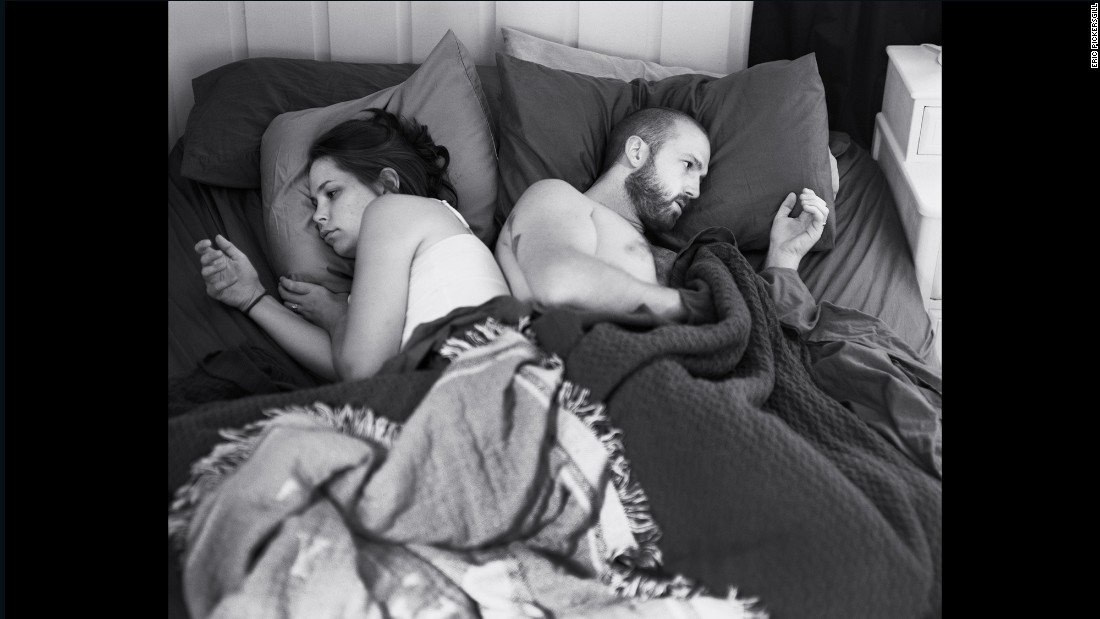 It's a common digital age moment.
It's a common digital age moment.
Conceptual
artist and photographer Eric Pickersgill had fallen asleep with his
cell phone in hand when the device dropped and thumped on the floor.
Startled awake, he noticed his hand looked like it was still cradling
the phone, thumb ready to scroll.
He was beholden to his phone even while unconscious.
The
moment solidified an idea that had been percolating in Pickersgill's
mind ever since a recent trip to New York. He was working in a café one
morning, seated next to a family of four. The father and his two
daughters were playing on their phones while the mother stared
lonesomely out the window.
"It was like
she could have been standing in the middle of the desert alone and the
light was really beautiful on her face," he said. "And as a
photographer, it was one of those moments that just was an image, and it
kind of stuck in my mind in that way."
Then
he fell asleep with his phone. "That's when it kind of clicked. I saw
the possibility of a photograph with having the device not in hand."
He soon settled on his next photo project: "Removed."
The series captures what we look like when we're in public yet absorbed
in our mobile devices. The only thing missing from the pictures? The
devices themselves. It makes for a striking set piece: a person
captivated by, well, nothing.
Criticizing
the modern attachment to technology is not a new concept, he's aware,
but Pickersgill set out to explore it in his own way. He shoots with a
large format view camera; it looks like a big box on a stand, covered by
cloth. He uses the old fashioned technology in part because of how it
contrasts with the cell phone.
"I have
previous work where I was out in the world with the view camera and
using that as a way to create connections with other people," he said.
"One could argue is kind of juxtaposed to what the cell phone does,
which isolates other people from us in public, so you can use it to
present the occupied or unapproachable."
Pickersgill,
29, started by having family and friends pose with their devices, then
slipping the phones out of their hands for a photo exposure. He moved
onto approaching strangers who were on their devices in public, asking
whether he could photograph them.
His
subjects are drawn in by the opportunity to "perform" for the camera --
posing with the phone and then without. The odd camera choice helps. "It
validates my presence. People are like, 'Oh this is art.'"
As
he embarked on the series, Pickersgill thought about how mobile phones
and the wealth of information they provide might be making us socially
impoverished, and even causing medical issues like sleep disturbance. He
resolved to stop leaning on his phone so much, and complained to his
wife, Angie, about their habit of using phones just before bed. The
devices were often the last interaction each had before sleep.
"I'm
hoping there are going to be some families that see this work and they
put a basket by the door and the phones go in it before they all sit
down to dinner," he said.
Pickersgill,
who recently earned an MFA from the University of North Carolina in
Chapel Hill, says he doesn't want to come across as holier-than-thou
with the project. His own attempts to distance himself from his mobile
device have been met with varying success; he always goes back to it,
and compares the attachment to an addiction.
"I'm definitely implicated in this work. I think everybody is."
Observers
have accused him of hypocrisy, he said, because he's gaining attention
for artwork that uses the very technology he's portraying negatively.
He
hopes the takeaway is that we pause to consider how much time we're
unnecessarily using our phones when we could be interacting with each
other. It all goes back to that mom and her hyperconnected family.
"With
the work I'm not trying to tell anybody how to live their lives," he
said. "I just am trying to create a moment for other people that is
maybe as impactful as the moment I had at that café, which kind of
brings it all back full circle for me."
Comments
Post a Comment